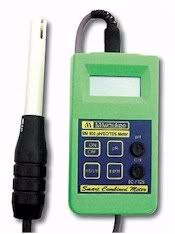Conductivity is a measure of the rate at which a small electric current flowsthrough a solution. When the concentration of nutrients is greater, thecurrent will flow faster. When the concentration of the nutrients is lower,the current will flow slower. You can measure your nutrient solution to determine how strong or weak itis with an EC (electrical conductivity) or TDS (total dissolved solids) meter.An EC meter usually shows the reading in either micromhs per centimeter (uMho/cm) or microsiemens per centimeter (uS/cm). 1.0 uMho/cm isequivalent to 1.0 uS/cm. A TDS meter usually shows the reading in milli-grams per liter(mg/l) or parts per million (ppm).
EC is generally measured at 77 F (25 C). If the temperature of the solution is raised, the EC will read higher, even though no nutrients have been added. If the temperature drops below 77 F (25 C), the EC will decrease.Therefore, it is important to always measure your EC at a consistent temperature of 77 F (25 C). Some EC and TDS meters compensate for varying temperatures. Another measurement in conductivity is CF (conductivity factor) which is expressed on a scale of I -100. Pure water containing no nutrients is rated at 0 and maximum strength nutrients would rate 100.
In low light conditions (winter), a hydroponic grower should increase the concentration of nutrients in solution in a hydroponic garden. In high light conditions (summer), a hydroponic grower should decrease the concentration of nutrients in solution in a hydroponic garden.
Measuring Conductivity
5:58 AM
ThanateTan







